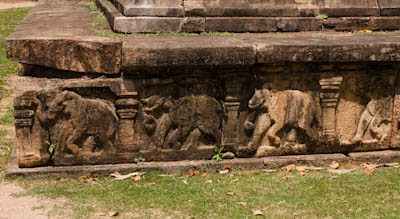Early the next morning we began the downward drive from Kandy to the UNESCO site of Polonnaruwa. Some of the towns we passed through were predominantly Muslim, its men wearing white caps, loose clothing, and donning henna beards. The dress of women varied from jeans to the burqa. Occasionally I spotted the orange robe of a Buddhist monk. Buddha statues of differing sizes and materials were lined up in front of some stores and stands, waiting for the eager buyer. The occasional church added some variety. Along the way, we also passed by numerous signs touting spice gardens or hotels. Over four hours later, we were in Polonnaruwa, the second capital of Sri Lanka after Anuradhapura was destroyed in 993 AD.
 |
| Royal Palace |
Prior to visiting the archaeological site, I decided to visit the museum. It gave a good idea of how the structures once looked, especially those that had wooden upper portions. Most where destroyed by Chola invaders, leaving very little remaining. Black & White photos of some structures as they were just prior to restoration illustrated just how destructive the jungle can be, particularly trees and vines. I was surprised by how Chinese many of the buildings looked, but learned that Chinese architects and workers were involved in the construction – a testament to global trade, even in ancient days. The museum also had artifacts taken from the site, such as some beautiful Hindu bronze statues, coins from various countries (found in the trading stalls), pottery, and jewelry.
On the way out of the museum, we drove past the huge tank that looked more like a lake. Remnants of two brick walls, constructed to protect the inner and outer city, were visible in some places.
 |
| Audience Hall |
Royal Palace Group
The first set of buildings we visited is known as the Royal Palace group. It included the Royal Palace, built during the reign of Parakrambahu I. Measuring 31x13 meters, at one time it supposedly had seven storeys. According to the scale model of the palace seen in the museum, the palace’s top floors were made out of wood. Hence, after the South Indian invaders set fire to the place, nothing remained except the brick ground floor walls (now charred) with holes to receive floor beams of the next level. Portions of plaster on the wall still remained in some places. Nearby was the Audience hall, which had a great row of elephants carved in relief on the bottom row, lions on the top, and remnants of columns. We also visited the Bathing Pool, whose water was provided from the large tank and channeled down through clay piping. A small circular fountain still occupied the middle of the pool, once spouting forth with water.
 |
| Bathing Pool |
No comments:
Post a Comment